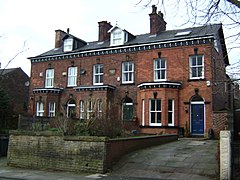Clifton, Greater Manchester
| Clifton | |
|---|---|
 Housing on Rake Lane near the railway station |
|
| Clifton shown within Greater Manchester | |
| OS grid reference | SD775035 |
| Metropolitan borough | |
| Metropolitan county | |
| Region | |
| Country | England |
| Sovereign state | United Kingdom |
| Post town | MANCHESTER |
| Postcode district | M27 |
| Dialling code | 0161 |
| Police | Greater Manchester |
| Fire | Greater Manchester |
| Ambulance | North West |
| EU Parliament | North West England |
| UK Parliament | |
Clifton is a small town within the metropolitan borough of the City of Salford, in Greater Manchester, England. Historically in Lancashire, it lies alongside and in the Irwell Valley in the northern part of the City of Salford. Clifton, a former centre for coal mining, once formed part of the Municipal Borough of Swinton and Pendlebury.
Clifton is derived from the Old English clif and tun, and means the "settlement near a cliff, slope or riverbank". Clifton was mentioned in the Pipe Roll of 1183–84.
Clifton Hall Colliery was situated a few yards to the west of Lumns Lane on a site currently occupied by a domestic refuse and recycling site, run by the Greater Manchester Waste Disposal Authority. It is thought that the colliery was operating by 1820, and its tramway is shown on a parliamentary plan from 1830 and an 1845 map. The colliery closed in 1929.
On 18 June 1885, an underground explosion at the colliery killed 178 men and boys. It is thought the explosion was caused by firedamp igniting on contact with a candle. Blacksmith George Hindley (aged 16) and fireman George Higson, were part of a band of men who descended into the mine immediately after the explosion. They received an Albert Medal (2nd class) in recognition of their heroism.
Wet Earth Colliery was another early coal pit located in Clifton. Having closed in 1928, its remains can still be seen in Clifton Country Park, very close to the River Irwell, the Manchester-Preston railway line, and near the bottom of Clifton House Road which runs uphill from the valley to its junction at the top with the A666, Manchester Road just opposite Clifton Cricket Ground.
...
Wikipedia

